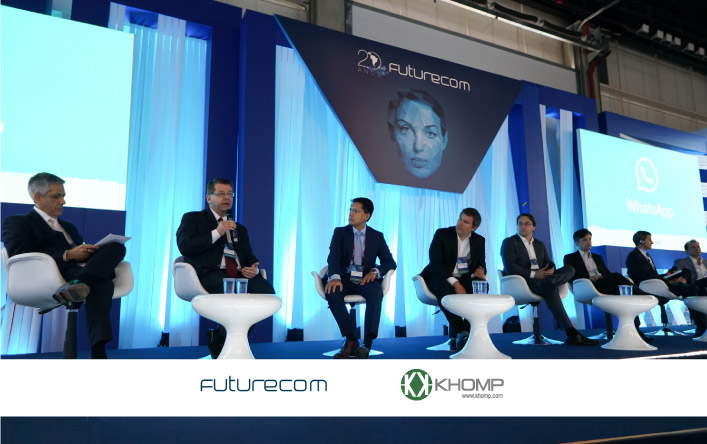The second day at Futurecom 2018 started with a subject that is keeping many awake at night: Network Transformation: The ultimate step to engage clients and capture new revenue sources.
Given the context, the panelists presented perspectives for both the end-users and the providers, providing an example of this ecosystem, which includes the universe of IT, IoT, integrators, cloud computing and 4G (and future 5G) Internet provisioning.
Wagner Ferreira, Director at Conecta Planejamento e Serviços, was the mediator of the debate and started the discussion by inviting Walter Sanches, CIO of Termomecânica — representing an important niche: the industry —, to speak.
“Our main difficulty in metallurgy is that we need to grow a lot — not only geographically, but also in terms of revenue. To do so, we need to master the technologies we use, whether it is Big Data, Artificial Intelligence, Industry 4.0 etc.,” he says.
For Sanches, this technological requirement is justified by the high market demand, which is escalating at high speed. “And I am not talking only about my area, but about the industry in general,” he states.
The long-term solution for them was to virtualize the systems that required enhanced reliability and migrate all others to the cloud, while maintaining the intercommunication between them.
As a result, Sanches now sees that “multicloud”, as he names it, is the word of the day. “This means having a resilient network, preferably with everything wirelessly available,” he explains.
Industry 4.0 has come to stay
“In order to be fast and create solutions that use our services, we need scalability support and a massive infrastructure. And by this I mean the virtualization of the integrated infrastructure,” explains Marco Di Costanzo, Engineering Director at TIM, when questioned about the network transformation process.
Ron Porter, NFV Specialist at Amdocs, adds that all these new technologies need to be able to interact and coexist within the transformation process.
“If we think about the cloud technology process, what it looked like years ago, we can see that a lot has evolved and that new opportunities have arisen along with the changes,” he adds.
Virtual reality is tied to connections and infrastructure
At this point, the discussion turned to the importance of providing adequate, dynamic services that can really add value to the customer’s day-to-day operations, without adding to the cost.
Hector Silva, CTO and Strategic Sales Leader for Latin America Ciena, spoke about the lack of dynamism in the delivery of virtual elements by the providers.
Such elements are related to the 5G mobile connection. “This connection needs to be fed by a real-time analytics intelligence system to allow for more assertive and optimized actions. And, a third element here is the orchestration of this control,” he completes.
Customer support related to the use of these technologies is another obstacle in the opinion of some executives, in the context of automation and artificial intelligence.
Competitiveness
Lucas Vanagas, South America Managing Director at Infinera, focused on the competitive phase the carriers are going through, in terms of the software architecture area where fiber capillarity is critical. “And this is a good thing, because it is the only way for needs to be fulfilled,” he concludes.
On the other hand, the speakers have a clear understanding that there is a lot of work to do, including in markets like Data Centers, fiber optics and IP structure.
“The challenge is to make this capability available to the user. To bring intelligence and strategy into this network investment. We went from one virtualized environment to another, the “cloudified” one, explains Rodolfo Luiz Fiasco, Executive Solution Sales Manager at Huawei.
How to get ready for the change?
“The key to dealing with so many digital transformations is the continuous monitoring of the feedback we receive from the end users regarding our deliveries,” says Francisco de Paula, Head of ICT Brazil at RedHat.
According to this expert, we also need to tailor a business model that will make our portfolio viable, such as standards to enable new offerings. The carriers have forced the ecosystems to work in partnership there,” exemplifies De Paula, regarding the costs of technology.
“Today we have an extremely high level of automation. To be able to integrate this with your client’s investment, you have to live up to such technology. I believe this is the main contribution open source can bring to this universe,” he explains.
And, finally, Walter Sanches answers the question everyone is asking: what does he expect as a quality service?
The answer is as objective as possible: “We are pushing things in right now. We have pushed the clouds and Data Centers in. But we have to deal with the complexity of simplifying all this. For example, we still need cables in our operations!”.
Sanches’s dream solution is to have a reliable network that will solve all this management issues in a single device. With no complexities, no high costs and no cables.
“This dream has not been achieved yet, but has already been addressed. The first step was to move from selling analog solutions to digital solutions, then we had artificial intelligence, which is becoming more and more assertive and accessible,” says Di Constanzo.
There will be many challenges ahead until we reach calmer waters. Several markets offer new possibilities, such as agribusiness, and they expect growth in image capture, for example, but this journey has many steps.
However, 2018 was a year of accomplishments in terms of achieving this goal. Unlike previous years, we are now closer to this virtual reality, in a more sustainable and real way.
